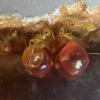I assume the bottom line of what you're asking here is what care differences do P. occidentalis and P. barbatus have. Assuming that's the case, here's what I can say;
Pogonomyrmex occidentalis are a primarily temperate species, meaning they require a period of hibernation every year. The colonies may get to a few thousand workers, but workers are generally small compared to other members of the genus. Their diet heavily relies on seeds (mainly grass seeds), and they may also scavenge for dead insects. The queens are semiclaustral, and will primarily feed on seeds during founding. They are a bit more docile than other Pogonomyrmex, but still pack a painful sting. They are totally unable to climb smooth surfaces, so no barrier is required. During their active period their optimal temperatures are around 85-90 degrees F, and that temperature will need to be lowered to around 45-50f for a proper hibernation.
Pogonomyrmex barbatus are a desert species, so no hibernation is required for them. The queen may take a few weeks in the winter and take a break from laying during this time, but no temperature changes are required for this to happen. The colonies can get well over 10,000 workers, and individuals are some of the largest in the genus. Their diet still relies heavily on grass and other seeds, but they also may act as predators, and as such a larger portion of their diet is to be made up of insect/invert protein. I personally recommend a ratio of around 65-70% seeds to 30-35% invert protein, although offering a larger amount of protein when there is a high amount of larvae present may be a good idea. The queens are fully claustral, and as such will not need any food to found. They are very aggressive, as is standard for Pogonomyrmex, and they pack a very painful sting. They struggle to climb smooth surfaces, but tend to be one of the better climbers in the genus, so a barrier or lid is probably smart. This is a heat loving species, so temperatures in the upper 80s to lower 90s are optimal year-round.
Liquid sugars are not required for either species, however they will typically be accepted in small quantities if offered. Due to their struggling with clinging to smooth surfaces, acrylic formicariums are typically not suitable for members of this genus. While a majority of information for housing and whatnot is transferable between P. occidentalis and barbatus, the two species are actually quite different, and require significantly different care. I hope this quick summary helps!




















